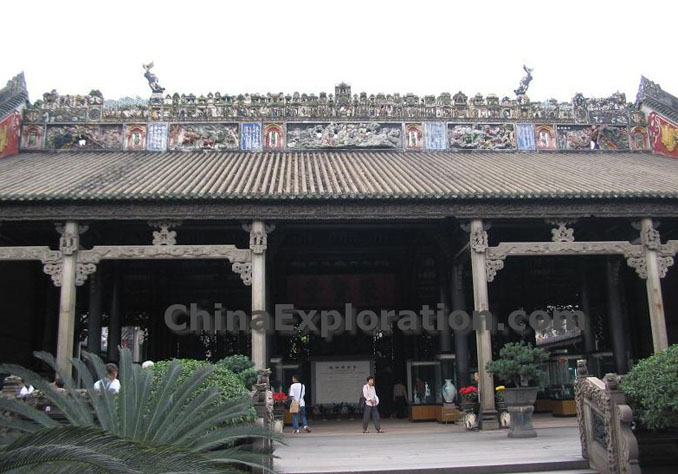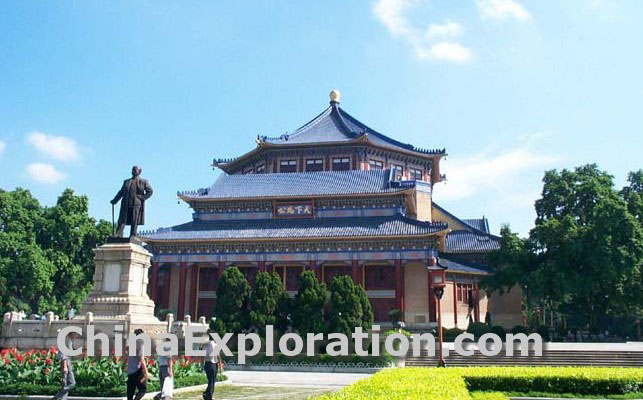search for a Trip
Introduction of Guangzhou
Guangzhou, located at the north of the Pearl River delta, is an important trading center as well as a busy port and the capital city of the province of Guangdong. The city has an area of over 16,000 square kilometers and a population of 6.7 million. Like Athens of Greece and Rome of Italy, Guangzhou also has a history of more than 2,800 years. There are a lot of interesting legends concerning its past. One of the beautiful stories which gives the city its name Goat Town says that five gods riding on five goats brought the first grain to the city. So, it is also known as the City of Five Goats. Guangzhou is also one of the most important centers of foreign commerce in South China. The Chinese Export Commodities Fair has been held twice a year in the city since 1957. It is also a cultural center. The city is renowned for its arts and crafts, namely the Guang Dong embroidery, ivory-carving and ceramics. Guangzhou is a beautiful city with an ever-green scenery and flowers blooming all the year round.
Main attractions in Guangzhou
Yuexiu Hill
 Yuexiu Park is located in the north of Guangzhou proper, around one km southeast to Guangzhou Railway Station. It is the largest park, with an area of up to 920,000 sq. meters. Apart from Yuexiu Hill, it also includes the neighboring six hillocks and three man-made lakes, i.e. Dongxiu Lake, Nanxiu Lake and Beixiu Lake. Yuexiu Hill got its name from the Chaohan Platform built by Zhao Tuo, king of Southern Yue in the Western Han period. It is also called Guanyin Hill, as Guanyin, Goddess of Mercy, was found during the Yongle years in the Ming Dynasty. Flowers and trees are planted all over Yuexiu Park, such as kapok for earlier spring, azalea for late spring, yulan magnolia for April, golden balsam and morningstar lily for May, hanxiao for autumn and wintersweet for midwinter. Spring flowers display and chrysanthemum show are held respectively in spring and autumn every year. There is a stadium in the park with a capacity of over 30,000 spectators and a swimming hall with a capacity of more than 5,000 spectators, plus other places for sports .
Yuexiu Park is located in the north of Guangzhou proper, around one km southeast to Guangzhou Railway Station. It is the largest park, with an area of up to 920,000 sq. meters. Apart from Yuexiu Hill, it also includes the neighboring six hillocks and three man-made lakes, i.e. Dongxiu Lake, Nanxiu Lake and Beixiu Lake. Yuexiu Hill got its name from the Chaohan Platform built by Zhao Tuo, king of Southern Yue in the Western Han period. It is also called Guanyin Hill, as Guanyin, Goddess of Mercy, was found during the Yongle years in the Ming Dynasty. Flowers and trees are planted all over Yuexiu Park, such as kapok for earlier spring, azalea for late spring, yulan magnolia for April, golden balsam and morningstar lily for May, hanxiao for autumn and wintersweet for midwinter. Spring flowers display and chrysanthemum show are held respectively in spring and autumn every year. There is a stadium in the park with a capacity of over 30,000 spectators and a swimming hall with a capacity of more than 5,000 spectators, plus other places for sports .
Baiyun Mountain
 People like to use ‘pearl sea and white cloud’ to describe the natural beauty of Guangzhou. Baiyun Mountain refers to the mountain range located 7.5 km north of Guangzhou and made up of 30-odd peaks, with an area of 28 sq. meters. The highest peak, Moxing Ridge (Star-scrapping Ridge) stands in the center of Baiyun Mountain, measuring 382 meters in height, also called ‘the First Peak under the Southern Sky’. In fact, Baiyun Mountain is the ending range of Dayu Mountains in the south. It stands up over the flat area of the Pearl River Delta, called ‘the First Mountain of Southern Yue’ in history. The mountain was named Baiyun (White Cloud) Mountain because of ‘ White cloud flying over Baiyuan Mountain, and gathering around its base’. ‘Wind Soughing in the Pines on Baiyun Mountain’ is one of the former ‘Eight Sights of Guangzhou’, the name coming from the sounds when wind blowing the pines on the mountain.
People like to use ‘pearl sea and white cloud’ to describe the natural beauty of Guangzhou. Baiyun Mountain refers to the mountain range located 7.5 km north of Guangzhou and made up of 30-odd peaks, with an area of 28 sq. meters. The highest peak, Moxing Ridge (Star-scrapping Ridge) stands in the center of Baiyun Mountain, measuring 382 meters in height, also called ‘the First Peak under the Southern Sky’. In fact, Baiyun Mountain is the ending range of Dayu Mountains in the south. It stands up over the flat area of the Pearl River Delta, called ‘the First Mountain of Southern Yue’ in history. The mountain was named Baiyun (White Cloud) Mountain because of ‘ White cloud flying over Baiyuan Mountain, and gathering around its base’. ‘Wind Soughing in the Pines on Baiyun Mountain’ is one of the former ‘Eight Sights of Guangzhou’, the name coming from the sounds when wind blowing the pines on the mountain.
Scenic Spots over the Pearl River
The Pearl River is where Guangzhou’s scenic spots are. Praises to the beauty of the Pearl River have been ‘Red Heart of the Pearl Sea’ and ‘Night Moon over the Goose Pool’, selected in 1962 as of the Eight Sights of Guangzhou, plus the ‘Sunlight Reflection at Shimen’ of the old Eight Sights of Guangzhou and the recently selected ‘Clear Waves of the Pearl River’ of the Eight Sights of Guangzhou. The third largest river in China, the Pearl River measures 2,129 meters in length, with its name deriving from the Haizhu Rock (Sea Pearl Rock). As the Pearl River was so wide 2,000 years ago, up to 2,000 meters, so it was also called the ‘Pearl Sea’. Later the river narrowed down to 900 meters wide during the Song Dynasty, and it is only 180 meters wide now.
The Pearl River Evening Cruise
Evening cruise on the Pearl River is one of the tourist highlights in the southern city of Guangzhou, and the beauty of the Pearl River can be compared with that of Hong Kong’s Victorian Harbor. The section of the river starting from the White Goose Pool to Guangzhou Bridge in the east and Baihedong in the south is the one for the Pearl River evening cruise, as the scenery of the Pearl River in this section is so fascinating, with jade-green water and beautiful lights, that it seems the long Pearl River is inlaid with seven-colored pearls, which forms a colorful rainbow of the Pearl River. On the way, one can appreciate such beautiful scenes of Guangzhou as ‘Night Moon over the Goose Pool’, ‘Misty Rain over the Twin Bridge’, ‘Red Heart of the Pearl River’, ‘Autumn Moon over the Pearl River’, ‘Clear Waves on the Pearl River’, etc. What is more, detailed introductions to the 30-odd historical and cultural sites are given via speakers so to enable you to taste to your heart’s content the local conditions and customs of the south.
Sun Yat-sen Memorial Hall
Sun Yat-sen Memorial Hall, a key historical relic protected by Guangdong Province, is a memorial building built with the funds raised by the Guangzhou people and overseas Chinese in memory of Sun Yat-sen, the great revolutionary forerunner. Located in the original site of the then Sun Yat-sen’s Presidential Office, it was designed by Mr. Lu Yanzhi, the great architect of the country. Construction work started in 1929 and finished in 1931. Sun Yat-sen Memorial Hall is a gorgeous octagonal structure, with solemn and magnificent looks, and strong national features. The designer smartly applied the structural theory of architectural mechanics and adopted the mixed structure of reinforced concrete. The construction space with the span of up to 71 meters is pillar-less, much to its grandeur. The memorial hall and the courtyard cover a land area of six hectares. The principal building occupies an area of 12,000 sq. meters, and 47 meters high. The stage measures 15 meters at the front and 20 meters in depth, together with 3,238 seats. Sun Yat-sen Memorial Hall is the most symbolized building of Guangzhou, and a key venue for the city’s large-scale meetings and performances as well.
Climate of Guangzhou
The climate of Guangzhou is sub-tropical. The average year-round temperature is 22C. August is the hottest month, with an average temperature of 28C. January is the coldest month, with an average of 13C. The rainy season falls between April and August. Average annual rainfall is 1,720 mm.
|
Month |
Jan |
Feb |
Mar |
Apr |
May |
Jun |
Jul |
Aug |
Sep |
Oct |
Nov |
Dec |
|
Temperature (Celsius) |
15.1 |
17.3 |
19.5 |
23.1 |
26.8 |
29.0 |
33.8 |
35.4 |
32.4 |
24.4 |
19.1 |
18.7 |
China Attractions Guide
- Anhui Attractions
- Beijing Attractions
- Chongqing Attractions
- Fujian Attractions
- Gansu Attractions
- Guangdong Attractions
- Guangxi Attractions
- Guizhou Attractions
- Hainan Attractions
- Henan Attractions
- Hongkong Attractions
- Hubei Attractions
- Hunan Attractions
- Inner Mongolia Attractions
- Jiangsu Attractions
- Jiangxi Attractions
- Manchuria Attractions
- Ningxia Attractions
- Qinghai Attractions
- Shaanxi Attractions


